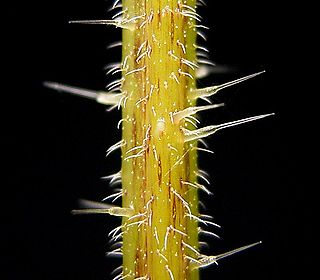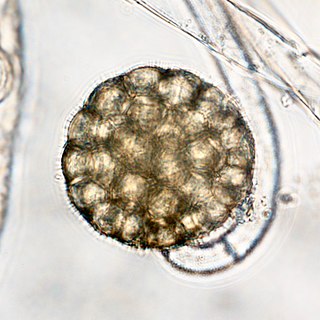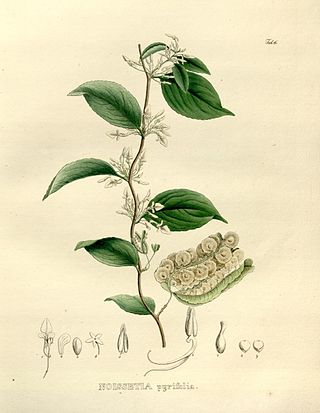
The Amazon rainforest, also called Amazon jungle or Amazonia, is a moist broadleaf tropical rainforest in the Amazon biome that covers most of the Amazon basin of South America. This basin encompasses 7,000,000 km2 (2,700,000 sq mi), of which 5,500,000 km2 (2,100,000 sq mi) are covered by the rainforest. This region includes territory belonging to nine nations and 3,344 formally acknowledged indigenous territories.

Violaceae is a family of flowering plants established in 1802, consisting of about 1000 species in about 25 genera. It takes its name from the genus Viola, the violets and pansies.

Francisco Alves Mendes Filho, better known as Chico Mendes, was a Brazilian rubber tapper, trade union leader and environmentalist. He fought to preserve the Amazon rainforest, and advocated for the human rights of Brazilian peasants and Indigenous peoples. He was assassinated by a rancher on 22 December 1988. The Chico Mendes Institute for Biodiversity Conservation, a body under the jurisdiction of the Brazilian Ministry of the Environment, is named in his honor.

The North Region of Brazil is the largest region of Brazil, corresponding to 45.27% of the national territory. It is the second-least-inhabited of the country, and contributes with a minor percentage in the national GDP and population. The area of the region is slighty larger than India or the whole European Union. It comprises the states of Acre, Amapá, Amazonas, Pará, Rondônia, Roraima, and Tocantins.

The Amazonian manatee is a species of manatee that lives in the Amazon Basin in Brazil, Peru, Colombia and Ecuador. It has thin, wrinkled brownish or gray colored skin, with fine hairs scattered over its body and a white chest patch. It is the smallest of the three extant species of manatee.

Tragia is a genus of flowering plants in the spurge family, Euphorbiaceae. It is widespread across North and South America, Africa, the Arabian Peninsula, the Indian Subcontinent, northern Australia, and to various islands in the Caribbean and in the Indian Ocean.

Dekeyser's nectar bat is a bat species found in Brazil and Bolivia.
PlowmanianthusFaden & C.R.Hardy is a genus of plants with 5 species and 2 subspecies in the family Commelinaceae. The genus is distributed from Panama to Amazonian Peru and Brazil.

Ocotea porosa, commonly called imbuia or Brazilian walnut, is a species of plant in the Lauraceae family. Its wood is very hard, and it is a major commercial timber species in Brazil.
Philcoxia is a genus of seven rare plant species in the Plantaginaceae that are endemic to Brazil and resemble terrestrial species of the genus Utricularia. The genus, formally described in 2000, consists of the species P. bahiensis, P. goiasensis, P. minensis, P. tuberosa, P. rhizomatosa, P. maranhensis and P. courensis, each of the first three named for the Brazilian state to which it is endemic. The species are characterized by subterranean stems, peltate leaves at or below the soil surface, and five-lobed calyces. Their habitat has been reported as areas of white sand in the midst of cerrado vegetation at an elevation between 800 and 1450 m. Initial descriptions of the genus included suspicions that the plethora of stalked capitate glands on the upper surfaces of leaves was an indication that these species may be carnivorous. A study published in 2007 tested P. minensis for protease activity, a typical test for the carnivorous syndrome, and could detect none. Later studies detected other digestive enzymes such as phosphatases and qualitatively assessed prey digestion and nutrient uptake, suggesting that it is a true carnivorous plant. The genus epithet honors David Philcox (1926-2003), a botanist at Kew Gardens who worked extensively in tropical Scrophulariaceae.

Spix's red-handed howler is a species of Howler monkey native to the southeastern Amazon in Brazil. It is threatened by deforestation and hunting.

Tragia durbanensis, the stinging nettle creeper, is a twining herb in the family Euphorbiaceae, with a restricted distribution in southern Africa. There are some 150 species in the genus Tragia.

Girardia is a genus of freshwater planarians belonging to the family Dugesiidae.

A stinging plant or a plant with stinging hairs is a plant with hairs (trichomes) on its leaves or stems that are capable of injecting substances that cause pain or irritation.

Backusella is the sole genus of zygote fungi in the family Backusellaceae, which is classified in the order Mucorales. Members of this genus have been often isolated from plant litter, from locations around the world.

Anchietea is a genus of flowering plants in the violet family Violaceae, with six accepted species, found in tropical South America.
Hybanthopsis is a genus of flowering plants in the violet family Violaceae, with a single accepted species, found in north-east Brazil.

Aniseia is a genus of flowering plants belonging to the family Convolvulaceae.

Theobroma speciosum is an arboriform species of flowering plant in the mallow family native to northern South America. It is the 35th most abundant species of tree in the Amazon rainforest.

Ypupiara is an extinct genus of unenlagiine theropod from the Late Cretaceous Serra da Galga Formation of Brazil. It was the first member of the Dromaeosauridae to be discovered in South America and the first member of the Unenlagiinae to be discovered, but not the first to be identified as such. The type and only species, Y. lopai, is known solely from a specimen that was destroyed in a fire in 2018.
















